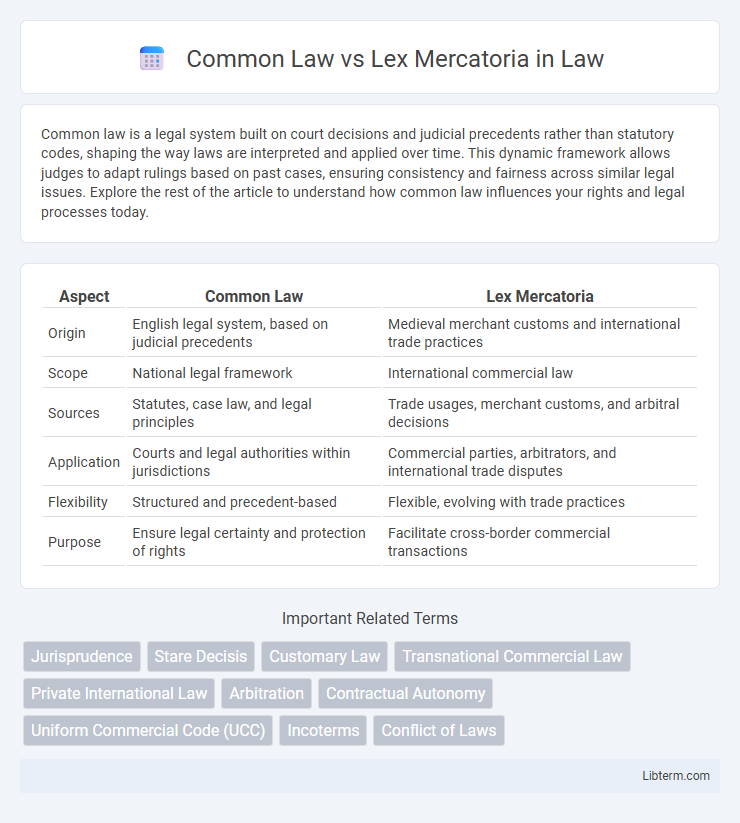Common law is a legal system built on court decisions and judicial precedents rather than statutory codes, shaping the way laws are interpreted and applied over time. This dynamic framework allows judges to adapt rulings based on past cases, ensuring consistency and fairness across similar legal issues. Explore the rest of the article to understand how common law influences your rights and legal processes today.
Table of Comparison
| Aspect | Common Law | Lex Mercatoria |
|---|---|---|
| Origin | English legal system, based on judicial precedents | Medieval merchant customs and international trade practices |
| Scope | National legal framework | International commercial law |
| Sources | Statutes, case law, and legal principles | Trade usages, merchant customs, and arbitral decisions |
| Application | Courts and legal authorities within jurisdictions | Commercial parties, arbitrators, and international trade disputes |
| Flexibility | Structured and precedent-based | Flexible, evolving with trade practices |
| Purpose | Ensure legal certainty and protection of rights | Facilitate cross-border commercial transactions |
Introduction to Common Law and Lex Mercatoria
Common Law is a legal system originating in England, characterized by case law developed through judicial decisions and precedents, which plays a central role in shaping legal principles. Lex Mercatoria, also known as the "law merchant," refers to a body of commercial rules and customs developed by merchants across Europe during the medieval period, serving as an early form of international trade law. Both systems influence modern commercial law, with Common Law providing structured legal frameworks while Lex Mercatoria emphasizes flexible, practice-based norms for cross-border trade.
Historical Evolution of Common Law
Common Law evolved from medieval English customs and judicial precedents, forming a consistent legal framework through court decisions rather than codified statutes. Its development was shaped by the Norman Conquest and the establishment of royal courts, which standardized laws across England. Unlike Lex Mercatoria, which arises from merchant customs and international trade, Common Law emphasizes judicial rulings and case law as primary sources.
Origins and Development of Lex Mercatoria
Lex Mercatoria, also known as the "law merchant," originated in medieval Europe as a body of commercial principles developed by merchants to govern transnational trade, independently of common law systems. It emerged from customary practices and merchant courts, evolving through practices such as maritime law and trade customs across different regions. Unlike the common law, which is rooted in judicial precedents and statutorily codified principles within a specific jurisdiction, Lex Mercatoria developed as a flexible and transnational set of rules fostering efficient commercial dispute resolution.
Key Principles of Common Law
Common Law is founded on precedent (stare decisis), ensuring consistency by requiring courts to follow previous judicial decisions in similar cases. It emphasizes case-by-case analysis with an adversarial system where judges interpret and apply laws based on factual circumstances. The principles of fairness, equity, and judicial precedent are central to Common Law, creating a flexible yet predictable legal framework.
Fundamental Concepts of Lex Mercatoria
Lex Mercatoria, or the "law merchant," is a set of fundamental commercial principles developed by merchants to govern international trade independently of national laws, emphasizing flexibility, fairness, and customs over rigid statutory codes. Unlike Common Law, which relies on judicial precedents and formal court procedures, Lex Mercatoria operates through universally recognized trade usages and equitable practices designed to facilitate cross-border transactions efficiently. Its core concepts include good faith, pacta sunt servanda (agreements must be kept), and the autonomy of contracting parties, fostering a self-regulating legal framework adaptable to diverse legal systems.
Jurisdiction and Applicability
Common law derives jurisdiction from national courts, applying statutory and case law within specific territorial boundaries, whereas Lex Mercatoria operates as a transnational body of commercial principles and customs recognized by international traders. Jurisdiction under common law is strictly tied to sovereign states, while Lex Mercatoria functions autonomously, influencing arbitration and contractual agreements across jurisdictions. Applicability of common law is mandatory within its jurisdiction, contrasting with the voluntary, party-driven adoption of Lex Mercatoria in international commercial disputes.
Differences in Dispute Resolution
Common Law relies heavily on judicial precedents and formal court procedures for dispute resolution, emphasizing case law and statutory interpretation by judges. Lex Mercatoria, rooted in customary international trade practices, favors arbitration and informal mechanisms guided by merchant principles rather than rigid legal codes. This results in Common Law providing predictable, jurisdiction-based rulings, whereas Lex Mercatoria promotes flexible, commercially driven solutions adaptable across diverse legal systems.
Influence on International Commercial Law
Common Law, with its precedent-based system, provides a flexible framework for resolving commercial disputes through detailed judicial decisions, influencing international commercial law by promoting predictability and stability in cross-border transactions. Lex Mercatoria, or the "Law Merchant," derived from customary trade practices and principles, shapes international commercial law by offering a transnational, adaptable set of rules that transcend national legal systems. The interplay between Common Law and Lex Mercatoria enhances international commercial law by balancing formal legal doctrines with pragmatic trade customs, thereby facilitating more efficient dispute resolution and contract enforcement worldwide.
Advantages and Limitations of Each System
Common Law offers predictability and detailed case precedents, ensuring consistent application of legal principles, but it can be rigid and time-consuming due to extensive litigation procedures. Lex Mercatoria provides flexibility and efficiency in international commercial transactions by relying on customary trade practices and party autonomy, yet it lacks uniformity and enforceability in some jurisdictions. Both systems complement each other, with Common Law's formal structure contrasting the adaptable, transnational nature of Lex Mercatoria.
Conclusion: Common Law vs Lex Mercatoria in Modern Practice
Common Law offers a structured, precedent-based system favored for its predictability and detailed procedural rules, making it dominant in domestic and international commercial disputes. Lex Mercatoria, rooted in customary merchant practices, provides a flexible, transnational framework that adapts swiftly to global trade dynamics without reliance on national legal systems. Modern practice increasingly integrates both, with courts recognizing Lex Mercatoria principles within Common Law contexts to balance legal certainty and commercial efficiency in cross-border transactions.
Common Law Infographic

 libterm.com
libterm.com